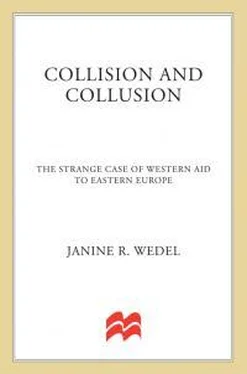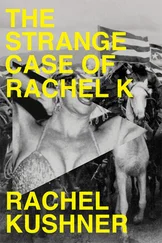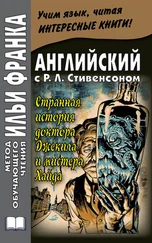The case studies in chapters 2 through 5 that make up the heart of this work point to a trade-off between aid administration that goes “by the book” and ensures accountability (but fails to encourage relations among recipients and donors and impedes recipient input) and aid administration that gives a free hand to selected donor and recipient representatives (but at the expense of accountability).
The aid story is not a static one. I chart a process of change through the 1990s, from the phase of Triumphalism through Disillusionment, and finally, in some cases, Adjustment, in which donors and recipients swayed each other. Donor standards sometimes influenced those of recipients in positive and welcome ways. In some postsocialist contexts, for example, I observed a trend toward incorporating impersonal “professional” standards and a growing movement away from practices in which economic and bureaucratic transactions were shaped by personal relations. In these contexts, young people who came into their own during the 1990s often appreciated and appeared to adhere to different standards from some of their elders. This contrasts with some earlier anthropological work by myself and others showing the pivotal role of informal relationships in economic and political life.
In addition to a focus on relationships, this work notes the language of aid generated by donors and sometimes emulated by recipients. I have learned a lot from the works of anthropologists who have dissected the discourses of development and analyzed the history, evolution, and power relations of “development” and development institutions.8 Several insightful anthropologists have shown that, although aid agencies tend to promise neutral technical solutions, they nonetheless reflect political ideologies that have important unanticipated consequences for the recipients.9 As we shall see in chapters 2 and 4, certain privatization and economic reform strategies, which appear to have been driven by ideological orientations, had powerful consequences.
This study differs from nearly all other works in development anthropology in its focus on the “Second World,” the nations of the former Eastern Bloc and the former Soviet Union. Nearly all studies in development anthropology concentrate on the “Third World”; critiques of development have thus grown out of fieldwork there. The ideas of the “Third World” and “development” both evolved in the context of postcolonialism and the Cold War; the idea of the “Third World” is closely intertwined with development models and institutions (as elaborated in chapter 1). The world after the Central and Eastern European revolutions of 1989 presented a dilemma for a development community now trying to operate in the “Second World”: While problems such as overpopulation and illiteracy figure prominently in development models, the industrialized and highly literate countries of the “Second World” presented a new development domain. And so, by its concentration on the “Second World,” this study further complicates the very idea of “development” and casts another pall over its post-Cold War future. With this study, I hope to encourage new domains of exploration in the anthropology of development as well as in the anthropology of policy.
IN THE FIELD
I began systematic study of this topic in 1991 in the Central European “Visegrád” countries of Poland, Hungary, and Czechoslovakia (named after their joint 1991 declaration signed in Visegrád, Hungary, to pursue common goals vis-à-vis the West), with interviews and participant observation. The West focused its aid efforts on these nations, which were seen as “models”—the most likely to succeed of the transitional countries. Because Poland is the most populous nation in the region and was the first to overthrow communism and to undertake radical economic reforms, Poland received nearly half the aid to the former Eastern Bloc. Thus, Poland is an essential part of the aid account, and the story, as told here, contains many illustrations from that country. (There are many parallels between the aid story in the more “advanced” Visegrád nations and the other nations of the Eastern Bloc. I focus on the Visegrád nations, where most of my fieldwork has been concentrated.) Later, when the aid frontier moved east, I began to examine assistance to Russia, generally the major donor priority in the former Soviet Union. When donors began to see Ukraine as important, I then followed some aid projects in that nation. (Despite some similarities, the political and strategic importance to the West of Russia and Ukraine renders their aid legacies significantly different from those of many other ex-Soviet states.)
I focus on “grant” aid—the technical assistance, training, and donations that do not have to be repaid by the recipients. Of the $80 billion in aid committed by the industrialized countries to Central and Eastern Europe from 1990 to 1996, some 40 percent consisted of grant aid (See appendix 1: Table 1). This study does not encompass such aid instruments as export credits or macrostabilization assistance, or loans provided by international financial institutions, except in cases in which the latter combine with grant aid projects otherwise under study. I set out to analyze some representative projects. I have included examples from the major (and some minor) donors and all recipient countries here covered (Poland, Hungary, the Czech Republic, Slovakia, Russia, and Ukraine). Although I did not attempt to study donors or recipients equally, the disproportionate attention I give to projects in Poland and Russia largely reflects donor priorities. And, because I set out to study the inter-reactions of the donors and recipients involved, there may be more cases in the book detailing problematic projects than “successful” ones. I describe positive cases in which donors influenced recipients’ adaptation of “professional” practices, but my focus on social processes is constant. (See appendix 2 for a discussion of methods.)
Conducting an ethnography across levels and processes has meant going back and forth between donor and recipient representatives and bodies and doing so frequently. During the course of my research, which has spanned more than a decade, I have spoken at length with aid principals in all the countries here named. This included on-the-ground fieldwork (in 1989-90, 1991-92, 1994, 1995, 1998, and 1999) in Central Europe, Russia, and Ukraine. An equally important part of my research has been extensive, in-depth interviews with representatives of the major Western donors: the United States, the European Union, Germany, and the United Kingdom.
Although I interviewed many prominent figures, the most valuable information was gleaned from repeated conversations over many years with many aid officials at all working levels (see appendix 3, Interviews). I also was privy to numerous meetings between donors and recipients at many levels. An international working conference I co-organized to bring donors and recipients together in an informal mode at the Woodrow Wilson International Center for Scholars in Washington, D.C. in April 1995 helped to frame many issues here discussed. The conference was titled “Western Aid to Central and Eastern Europe: What We Are Doing Right, What We Are Doing Wrong, How We Can Do It Better.” It is my hope that this book will help to advance the spirit and desire for understanding in which that conference was conceived—the spirit in which the East and West began the “transition to democracy.”
CHAPTER ONE
East Meets West: A New Order for the Second World
The radiance of Western justice and success is the power that caused the east European nations and the Soviet Union to abandon what they were and attempt to become what we, the democracies, have made of ourselves.… It is a moment to seize.
Читать дальше












